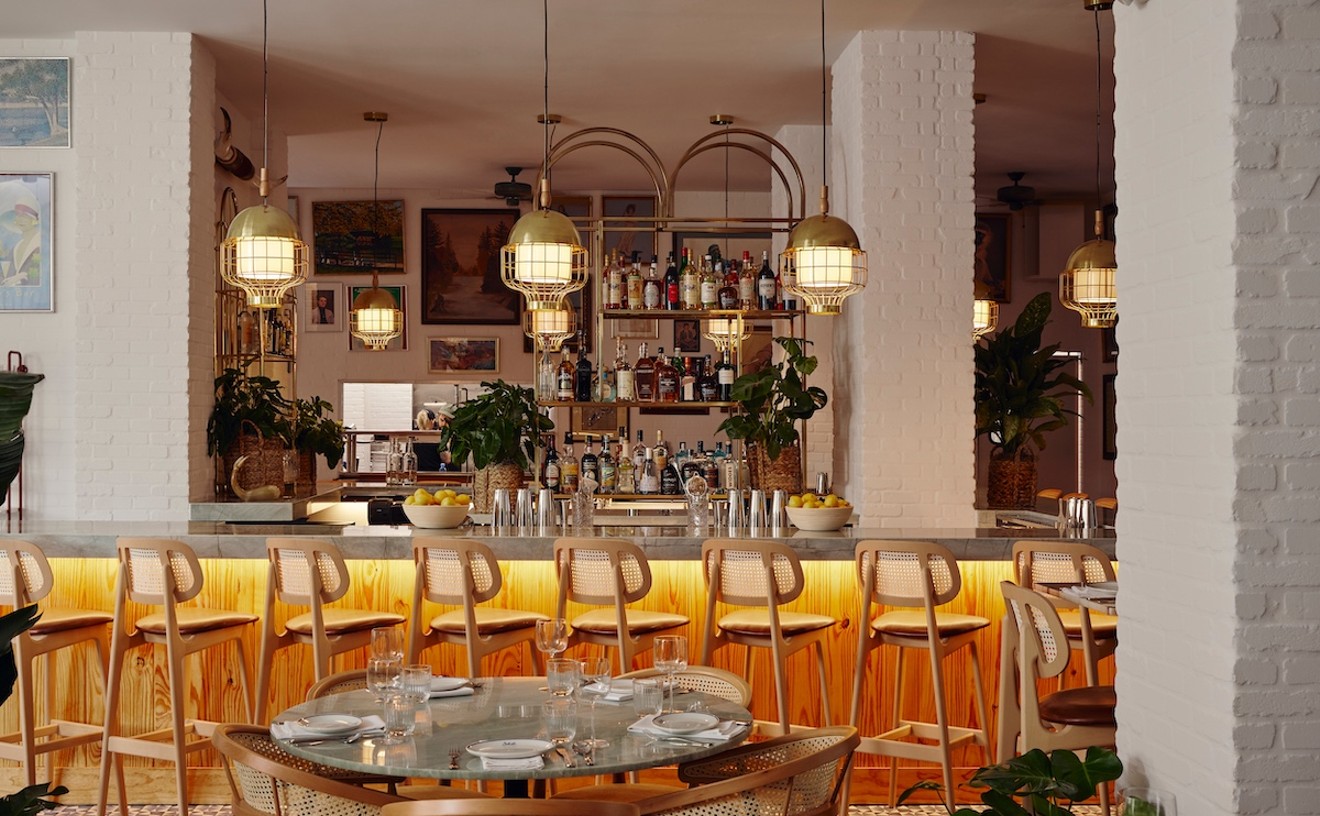The décor inside is almost as predictable, except for the rich mustard-yellow color of the walls; if they were red instead, Phillipe would look very much like other Spanish restaurants. It's a warm and cozy space: bottles of wine lined up in wooden and wrought-iron racks around the rectangular room; mirrors and numerous photos of Spain, notably Basque country, filling the wall space; fresh purple-and-white orchids perking up the linen-covered tables. The lighting is low, the music Latin, the thermostat set just right.
It's true the cooking from this region tends toward the simple, but that doesn't have to mean boring. Escabeche, for instance, is a zesty and piquant appetizer found throughout Spain, wherein small, cooked fish such as sardines, mackerel, smelts, et cetera, are steeped for at least 24 hours in a spicy marinade and served cold. A more nouvelle approach (nueva cocina vasca) can be found at the Restaurante Basque in Madrid, where one of the popular tapas is mussels and shrimp in avocado vinaigrette. No escabeche or avocado vinaigrette at Phillipe. The starters focused mostly on traditional, one-dimensional, two-ingredient shellfish combinations like shrimp in garlic sauce ($8.50), clams in green garlic sauce ($12.50), and mussels in marinara sauce ($8.95). The half-dozen shrimp were juicy, the clams meaty, their respective sauces similarly prepared with garlic, clam juice, white wine, and parsley. The mussels were teeny but clean and robustly flavored. We also sampled the roasted red peppers in "Basque-style sauce," which turned out to be garlic, olive oil, and balsamic vinegar.
An appetizer we didn't try was baby eels in garlic sauce, a true Spanish specialty that can be called adventurous. They also can be called expensive, as in $90 for a three-and-a-half-ounce serving for two of the spaghetti-size critters. Still, gotta give Phillipe credit for putting this on its menu. Whether anyone orders it, especially at this price, is another matter. It can be argued that the timidity of our restaurants is at least partly a reflection of the diners whom they serve.
Basque chefs pride themselves on how well they can cook their salt cod. Bacalao pil pil is one of the most famous of these preparations, made by baking the cod in olive oil and garlic, during which time the gelatin from the fish naturally thickens the oil into a mayonnaise consistency. Phillipe offers bacalao "à la Vizcaina" ($19.95), two squares of the firm-fleshed, assertively flavored cod in a garlicky pimento sauce of puréed roasted red peppers. Nicely done, but the smaller piece of fish was a dark-gray color; when shopping for salt cod, rule of thumb says the whiter the better. Like most meals here, the bacalao was served in a shallow earthenware cooking dish (cazuela), accompanied by a side of tomato-based Spanish rice.
Another popular Spanish dish from the Basque country is zarzuela (the word means "operetta"), a medley of shellfish with olive oil, garlic, smoked ham, tomatoes, almonds, saffron, white wine, lemon juice, and croutons. The shellfish arrangement here is called cazuela de mariscos and it comes in marinara sauce ($20.95). Many of the same ingredients (shrimp, mussels, and clams) accompanied a tasty, moistly cooked sea bass ($24.95) that was pooled in yet another garlic-white-wine-parsley sauce. If our ethnic restaurants are less than ambitious in general, when it comes to vegetables, they're downright negligent: Canned peas were the sole garden offering with the bass, and other entrées also were lacking in this regard. If you hunger for greens, there's a spinach salad ($5.95) and mesclun salad with balsamic vinaigrette ($6.95) available à la carte.
We passed on the paella Valenciana ($37.90 for two) because, quite frankly, we'd had our fill of shellfish. Instead we went with arroz Gaxuxa, a Basque rice specialty with chicken, roasted red pepper strips, and peas. The short-grain rice was imbued with chicken stock and a potent, pleasant-tasting onion and garlic sofrito, but it doesn't make much sense to use chicken breast in this particular preparation. A bird on the bone imparts more flavor, remains moister during the lengthy cooking time (30 minutes), and would lend substance to the dish, which is just what it needed. Serrano ham, chorizo, wild mushrooms, olives, scallions, or a fresh herb might have added some texture and taste as well. And $29.90, even for two people, is too expensive for just chicken and rice.
Crabmeat ravioli in pink sauce ($14.50) and linguini with tomato sauce ($9.50) are featured on the menu (which comes as no surprise, but can you imagine a Basque restaurant serving pasta dishes in any other American city? For that matter is there a Thai place left in Miami that doesn't serve sushi?), as are steak with green peppercorn sauce ($18,95), chicken with Dijon mustard and herbes de Provence ($12.95), rack of lamb with rosemary sauce ($19.95), and filet mignon in mushroom sauce ($21.95). The meat selections no doubt represent the French side of the Basque region.
Desserts such as warm chocolate cake with vanilla ice cream and roasted pecans, pear cooked in cherry wine and topped with vanilla ice cream, hot chocolate sauce and roasted almonds, and crêpes with vanilla ice cream, hot chocolate sauce, and roasted almonds are all, as you can pretty much see, thematically alike. They're also homemade and very good (most cost $5.95).
There is an oft-quoted statistic about how four out of every five restaurants fail. Four out of five also, at least in this region, exhibit an almost astounding lack of panache when it comes to cooking food. Wouldn't it be a coincidence to find that those survivors are the very ones that show a little flair and enthusiasm? Phillipe has friendly service, mostly fair prices, and decent food -- there really wasn't a bad item on the menu. Then again, there really wasn't a great one.











